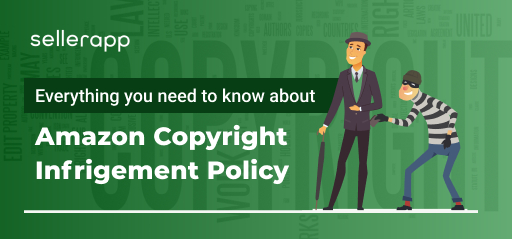A Comprehensive Handbook on Amazon Copyright Infringement for Sellers

The issue of copyright infringement has become a significant challenge on Amazon, with both false and legitimate complaints on the rise.
If you’re an Amazon seller, you’re likely aware of the severity of this problem in the marketplace.
In this article, we’ll provide you with a comprehensive understanding of everything you need to know about Amazon copyright infringement.
Quick Guide
- Amazon copyright infringement- Introduction
- How to report copyright infringement on Amazon
- How to claim copyright or trademark infringement on Amazon
- MAP violations – What you need to know
Amazon copyright infringement – Introduction
Amazon copyright and trademark infringement cases can be frustrating for sellers and business owners. Regardless of the outcome, they will have a negative impact on your business. Amazon restricts the infringement and takes measures to protect intellectual property rights. Amazon Brand Registry is one such program that helps eligible brand owners file a complaint about cases of rogue selling, protecting their IP rights, and brand erosion.
You can register your product under Amazon Brand Registry to protect your intellectual property rights. Amazon created the option of branding your items on the amazon. You can also register other types of intellectual property like trademark, patent, and copyright. When you register, Amazon automatically removes and deletes the content that hinders your copyrights.
When you sell on Amazon:
- You have to comply with state, federal, and local laws. Amazon policies apply to the products and listings only
- You cannot violate the IP rights of other owners or brands
If you want to add images to listings and products, you need to have copyrights. If you’re using someone else’s images, you need to get permission for it. If not, you are violating copyright laws. If you do not comply, it may result in legal consequences or a loss of selling privileges.
How to report copyright infringement on Amazon
Copyright violation happens at different stages on Amazon. Here’s a quick peek for you:
| ASIN-Level(ASIN stands for Amazon Standard Identification Number) | If you find your images or text on a product, packing, or any other place for which you didn’t give permission, you can report the ASIN under copyright infringement. |
| Image or text | If you find your text or images in the product listings without your permission, you can report them. In this case, the ASIN and the product details page will remain on the marketplace. |
| Seller-level | If you believe that an offer from a seller’s listing infringes your copyright, you can report it. Since the infringement refers to the offer, the ASIN and the listing details page still stand. |
For all the cases mentioned above, you can report a copyright infringement. Additionally, there are cases when someone:
- Uses your brand to sell items without permission
- Steals your ASIN
- Tries to make profits without permission
In such cases, you can report copyright infringement on Amazon.
To avoid further confusion, you need to keep in mind that you are also allowing Amazon to use that image by providing an image for the product listing page. Such circumstances may cause other sellers to take advantage of it. You may be limited later to assert a copyright infringement claim. There is also a disclaimer under which Amazon is protected, so you cannot rely on Amazon or other sellers. You need to understand and define your copyrights if you want to assert them successfully.
If you want to learn more on how to report copyright infringement on Amazon, take a look at this video.
How to claim copyright or trademark infringement on Amazon
If you think your product/brand has been impacted by copyright or trademark infringement, you should follow the procedure that is mentioned on the Amazon site. Besides, Amazon wants you to submit the infringement complaint via their forms.
For those of you enrolled in Amazon Brand Registry, you can use RAV (Report a Violation) feature within the Brand Registry. You can use the same form to report patents and other IP claims.
If you want to submit a report, you need to provide the following information:
- A physical or electronic signature of the person who acts as the owner who has the copyright interest
- A description of the trademarked, patented, or copyrighted work you claim has been infringed upon
- A description of the material you claim that has been infringed on the site. It can be on the product, packaging, image, or text description on the product listing page.
- The detailed list of products – either URLs of the product details page or the ASINs. See if you are accusing all the sellers on the product details page. If you observe only a few sellers in the listing who are infringing, you should click on the checkbox next to the name of each seller that you’re reporting under RoV (Report a Violation).
- You also need to add your address, phone number, and email address
- You can also add other relevant information that can help Amazon process the complaint (As part of it, you can add order IDs for test buys on the products)
- Add a statement that you have a “good-faith belief” that the disputed use is not authorized by the law, the copyright owner, or its agent
- You also need to add a statement under penalty of perjury that the information in your notice is appropriate. It should also have the information that you are the copyright owner or authorized to act as one
- Lastly, you need to send the notice to Amazon’s copyright agent. You can also send an email at copyright@amazon.com
There’d be a few situations where Amazon doesn’t enforce infringement under the product detail page ownership and image restrictions. When a product listing page is live, it’s permanent on amazon.com. It will remain even if your inventory depletes.
Note: When you add your copyrighted image, you give a non-exclusive and royalty-free right to Amazon and its affiliates to use them for publicity. Amazon works in a way that other sellers can list and sell their products under the listing you have made. However, the retail giant emphasizes that sellers must list only against the listing pages that match products.
So if you think the products don’t match and still the sellers are listings the items, you can report the trademark or copyright violation to Amazon along with the form mentioned above.
Also, these IP notices are limited to marketplaces. For instance, if you have a trademark registered in the US and want Amazon to remove an ASIN from Amazon Canada, they will likely reject it.
Recommended Guide: Amazon Manufacturer Part Number.
MAP violations – What you need to know
With selective or exclusive distribution, Amazon allows manufacturers’ rights to engage in exclusive distribution and MAP (minimum advertised price) agreements for the products. However, these violations are between the manufacturer and seller, and Amazon does not assist in such activities.
Are you selling on Amazon? When SellerApp is your growth partner, you will be equipped with the true power of AI-driven technology and Amazon experts that can help scale your Amazon business to new heights. Drop an email at support@sellerapp.com to learn more about our end-to-end solutions.
Additional Read:
Amazon Retail Readiness Checklist











Ronald
August 16, 2021Good Resource for Amazon sellers.
Vickie
August 16, 2021Wonderful information.